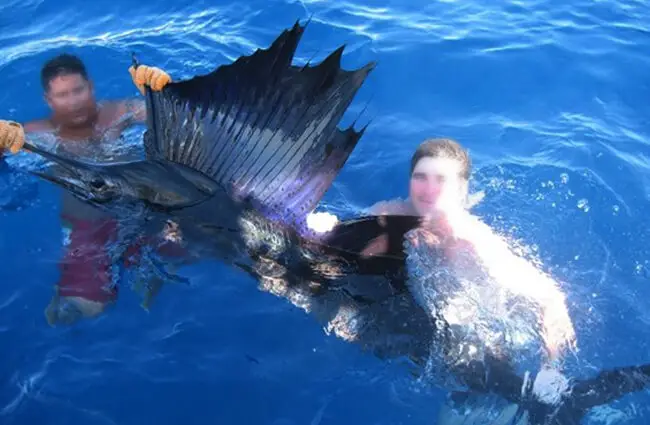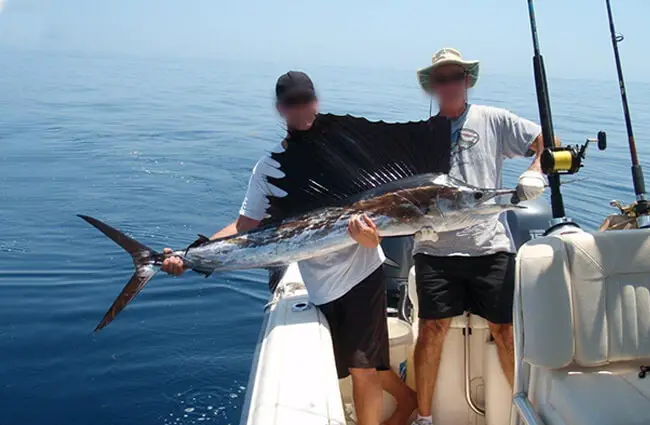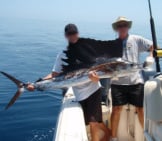The Sailfish is a member of the marlin, or Istiophoridae, family. Aside from other marlin species, these fish share relatives with the swordfish and the barracuda. Within the marlin family, researchers place the two species of Sailfish in their own taxonomic genus, Istiophorus. Read on to learn about the Sailfish.
Description of the Sailfish
You can easily distinguish these two species from the rest of their family by the large dorsal fins on their backs. The fin, which resembles a sail, runs down much of the length of their backs and gives them their name. Like all marlin, they have long, pointed bills.
Historically, these fish measured up to 11 feet long and weighed up to 220 lbs. or more. However, fishing pressure has greatly reduced the number of individuals that reach such impressive sizes. The average individual reaches just 4 or 5 ft. long and weighs about 150 lbs.
Interesting Facts About the Sailfish
These striking fish have a number of unique traits and adaptations. Learn more about what makes them so interesting below.
- The Two Species – Researchers have recognized two different species of Sailfish, the Atlantic and the Indo-Pacific. As their names suggest, the Atlantic species ranges the Atlantic Ocean, while the Indo-Pacific inhabits the Indo-Pacific region and the Pacific Ocean.
- Species Dispute – However, DNA research suggests that the two species could have no genealogical differences. For this reason, many governing bodies consider only a single species valid, platypterus.
- The Sail – Despite the fact you’ve probably only ever seen one depicted with its sail up, this fish typically swims with the sail folded down to its back. This helps streamline its body and swim faster.
- Sail Function – Researchers have determined that these fish raise their sails when they hunt for fish. They believe the sail reduces the movement of the head, making the long bill harder for the fish to see.
Habitat of the Sailfish
Both species utilize pelagic, or open ocean, habitats. They do not live in close association to the coasts or the sea floor. More specifically, they live within the epipelagic zone, or the area from the surface of the ocean to as deep as light penetrates. They spend most of their time near the surface, though they do occasionally swim in deeper waters.
Distribution of the Sailfish
You can find these fish in tropical and temperate waters across the globe. They migrate seasonally, moving away from the equator in the summer and back towards tropical regions in the winter. The different species utilize different regions. You can find these fish in the Atlantic, Pacific, and Indian Oceans.
Diet of the Sailfish
These fish have carnivorous feeding habits, which means that they eat other animals. Their diet consists primarily of fish and seafood, which makes them piscivores. Generally, they eat small fish and squid. Some of the different types of prey that they target include anchovy, herring, mackerel, and more.
Their hunting method differs from most predatory fish. As this fish swims into a school of fish, it swipes its long bill sideways, using it to stun and kill fish. After swinging its bill, it quickly eats the fish.
Sailfish and Human Interaction
People target this fish for sport, as is the case with most species in the marlin family. In addition to targeting by sport fishermen, these fish also face danger from commercial fisheries targeting other fish species. People also eat this fish as well.
Domestication
Humans have not domesticated this fish in any way.
Does the Sailfish Make a Good Pet
No, you could not keep this fish as a pet. They grow much too large to house in a home aquarium.
Sailfish Care
People do not keep these fish in aquariums. They live pelagic and migratory lifestyles, and their long bills can easily become damaged from hitting the sides of an aquarium.
Behavior of the Sailfish
These fish live in small groups or alone as adults. Juveniles congregate into larger schools. They spend most of their time swimming near the surface of the water in search of prey. Seasonally, they undergo long migrations.
Reproduction of the Sailfish
These fish reproduce via spawning, where the females release their eggs and the males fertilize them outside of the body. The females use their dorsal fins to attract a mate. A single female can produce over a million eggs. It takes between two and three days for the eggs to hatch into the larval young, and between three and four years for the young to reach sexual maturity.

![Sailfish hunting sardines in the open ocean off the coast of Mexico Sailfish hunting sardinesPhoto by: Rodrigo Friscione / NOAA's National Ocean Service [public domain]https://creativecommons.org/licenses/by/2.0/](https://animals.net/wp-content/uploads/2020/02/Sailfish-2-650x425.jpg)




![Sailfish hunting sardines in the open ocean off the coast of Mexico Sailfish Hunting Sardinesphoto By: Rodrigo Friscione / Noaa'S National Ocean Service [Public Domain]Https://Creativecommons.org/Licenses/By/2.0/](https://animals.net/wp-content/uploads/2020/02/Sailfish-2-162x141.jpg)




![Red Angus Closeup of a beautiful Red Angus cowPhoto by: U.S. Department of Agriculture [pubic domain]https://creativecommons.org/licenses/by/2.0/](https://animals.net/wp-content/uploads/2020/03/Red-Angus-4-238x178.jpg)












![Red Angus Closeup of a beautiful Red Angus cowPhoto by: U.S. Department of Agriculture [pubic domain]https://creativecommons.org/licenses/by/2.0/](https://animals.net/wp-content/uploads/2020/03/Red-Angus-4-100x75.jpg)

